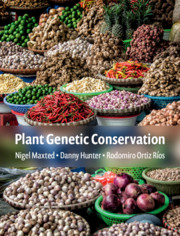Book contents
- Frontmatter
- Frontispiece
- Contents
- Foreword
- Preface
- Acknowledgements
- Part I Introduction
- Part II Scientific Background
- Part III Conservation Practice
- Part IV Plant Exploitation
- 14 Plant Uses
- 15 Germplasm Evaluation
- 16 Plant Breeding
- 17 Participatory Plant Breeding
- 18 Conservation Data Management
- Acronyms and Abbreviations
- Glossary
- References
- Index
- Plate section
14 - Plant Uses
from Part IV - Plant Exploitation
Published online by Cambridge University Press: 05 September 2020
- Frontmatter
- Frontispiece
- Contents
- Foreword
- Preface
- Acknowledgements
- Part I Introduction
- Part II Scientific Background
- Part III Conservation Practice
- Part IV Plant Exploitation
- 14 Plant Uses
- 15 Germplasm Evaluation
- 16 Plant Breeding
- 17 Participatory Plant Breeding
- 18 Conservation Data Management
- Acronyms and Abbreviations
- Glossary
- References
- Index
- Plate section
Summary
Humans have used plants in numerous ways to meet their multiple needs since the early days of our existence. Plant use ranges from their indirect use for recreational, health and amenity purposes to their direct use as food, medicines and as a source of useful variation for plant breeding and crop improvement. Traditional and Indigenous cultures have relied on the use of plants for many thousands of years, whereas commercial exploitation is more recent. Ethnobotany is the study of the relationship that exists between people and their use and knowledge of plants. Economic botany is also a term often used to describe how people have and continue to use and exploit plants. For certain plant species a number of factors have contributed to their overexploitation. The same 2016 State of the World’s Plants also points out that over 30,000 plants are now protected under CITES, the global convention on trade in endangered species. For other plant species and varieties many remain neglected and underutilized and there are many socio-economic, political and technical barriers preventing their sustainable conservation and utilization. The purpose of plant genetic conservation is to make plants and plant-derived products available for sustainable utilization.
Keywords
- Type
- Chapter
- Information
- Plant Genetic Conservation , pp. 393 - 427Publisher: Cambridge University PressPrint publication year: 2020



